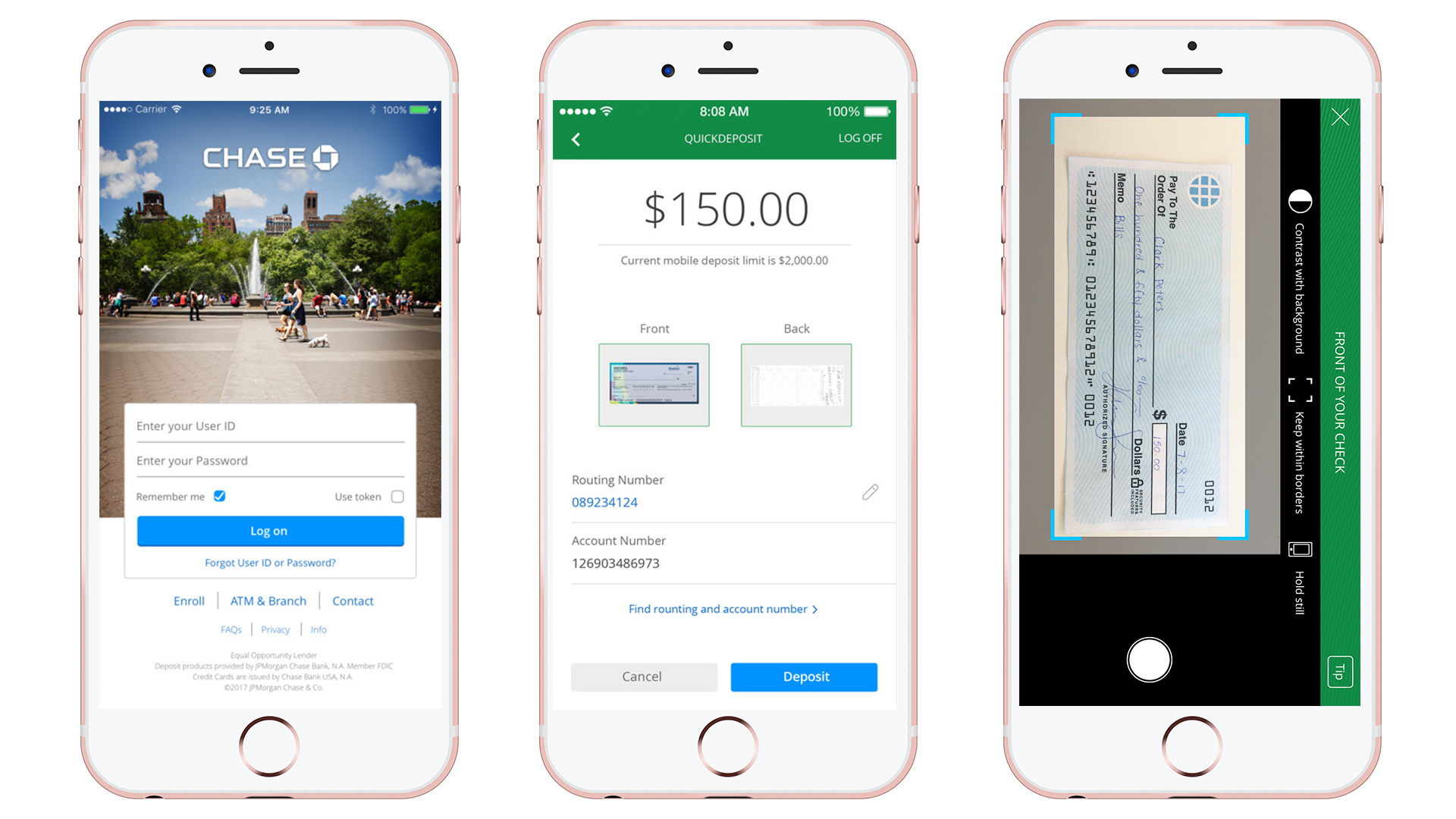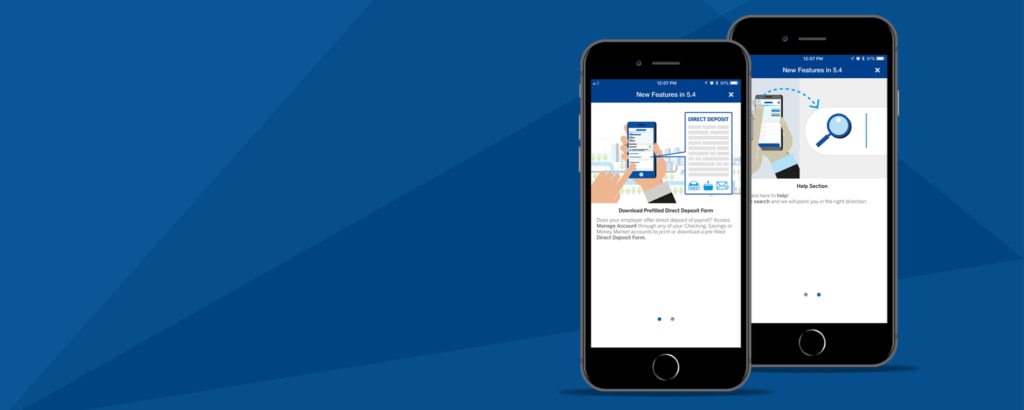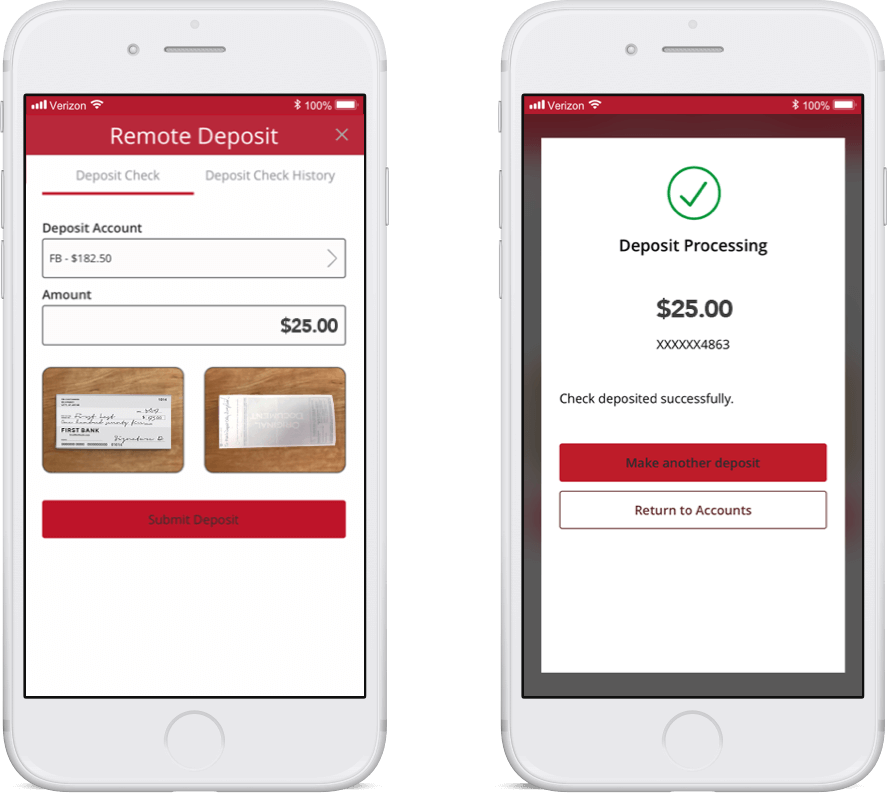Mobile Check Deposit App

Your bank can cap how much you can deposit. Banks will typically place a limit on the dollar amount. Deposit checks anytime, anywhere, 24/7 with NASA FCU Mobile Remote Deposit. Simply snap photos of the front and back of your checks with your phone and securely upload the photos for deposit into your NASA Federal Credit Union account. With Mobile Remote Deposit, make deposits in 3 simple steps: 1. Launch the Mobile Remote Deposit Application 2. Read reviews, compare customer ratings, see screenshots, and learn more about Citi Mobile Check Deposit. Download Citi Mobile Check Deposit and enjoy it on your iPhone, iPad, and iPod touch. Citi Mobile Check Deposit provides Citi TTS clients the ability to quickly and easily deposit checks from anywhere using their iPhone. Mobile Check Deposit allows you to make check deposits anytime, anywhere with the SmartBank mobile app. Depositing funds has never been easier, in fact it’s a snap! Steps for using Mobile Check Deposit Using your SmartBank mobile app, go to the list of available actions.
Are you familiar with mobile check deposits?

This means you can deposit checks without going to the bank. And, being able to deposit paper checks, such as a stimulus check, without going to the bank can make things super convenient.
Wondering how to deposit a check this way? If you’ve never used mobile check deposit before, it’s not as difficult as you might think. Take a look at 5 tips that can help you make the most of this feature – saving you valuable time.
1. Check your bank’s mobile check deposit guidelines
Mobile Check Deposit App Free
The first thing you need to do is make sure the organization you’re banking with is set up for mobile check deposits. The easiest way to do that is to check your mobile banking app.
When you log into mobile banking, head to the menu and look for the mobile check deposit option. If you see it listed, then your app should allow you to deposit checks online.
Before you try to use mobile check deposit, however, make sure your account is enabled to do so. While the feature may be available in mobile banking, you may still have to register first or sign up.

2. Review mobile check deposit limits
If you know that you’re able to deposit a check through mobile banking, the next step is to determine whether there are any limits on deposits.
For example, some financial institutions impose limits on the number of checks you can deposit per day or per week. There may also be daily, weekly or monthly limits on the total dollar amount you can add to your bank account using mobile check deposit.
So, make sure you can deposit your check without going over those limits. For example, say you’re married with two kids and you received a federal stimulus check for $3,400. If your bank’s mobile check deposit limit is $5,000 per day, you should be able to deposit the entire check online.
You can usually find out about limits if you read your bank account’s terms and conditions. You can also check your online banking website and look for a section on frequently asked questions. Sometimes this is a good place to start.
What if your check is outside mobile check deposit limits? In this case, you’ll need to find a work-around for depositing it into your bank account. With online bank accounts, for instance, you may have to deposit the money to a checking account at a brick-and-mortar bank, and then move it into your other account via an ACH transfer.
3. Get your check ready for deposit
Depositing a check online isn’t exactly the same as depositing it at a branch or ATM. But you still have to sign the back of the check for the deposit to be valid. You also should make sure all the information on the front of the check is correct.
Depending on your bank account, you may also have to write something extra on the back to denote that it’s a mobile deposit. For example, you may have to add “for mobile deposit” or “for remote deposit capture” below your signature.
Also, make sure the check is legible. Your mobile device needs to be able to “read” the check via the camera when you’re ready to deposit it.
4. Deposit your check via mobile banking
Now you’re ready to deposit a check online!
The process can be different depending on your particular bank account. But generally, here’s what you need to do:
- Log into your mobile banking app
- Find the mobile check deposit option in the menu
- Select the account you want to deposit the check into (i.e. checking or savings)
- Enter the check amount
- Snap a photo of the check – front and back. It’s important to make sure you get a clear image of both sides of the check. Otherwise, you may have trouble completing a mobile check deposit. If the images come out fuzzy or blurry, clean off your camera lens. And, make sure you take photos in an area with good lighting so your camera can pick up details on your check.
- Once your device records the images of your check, review the deposit details. Make sure that you’ve signed the check, selected the right account, and entered the correct amount.
5. Wait for the check to clear
If you deposit a stimulus check – or any check – online, you may want to use the money right away. But, you’ll need to wait for the check to clear in your bank account first.
You may now wonder how long it takes for mobile check deposits to clear. Well, this depends on your bank account, the amount of check, and the type of check involved. Again, check your bank account terms and conditions or read through the FAQs. This might offer up some clarity on how long your mobile check deposit will take to be fully credited to your account.
In the meantime, don’t throw the check away. Why? Because there may be a hiccup with your mobile check deposit. If you don’t see the deposit in your account within a week, you may need to call your financial institution to find out what’s happening. You may also need to try making the deposit again.
Once your mobile check deposit clears your bank account, you can then write ‘void’ on the check and file it away.
How to deposit IRS checks with Mobile Check Deposit using Chime
If you are a Chime member and received a government stimulus payment as a paper check, you can deposit it safely and securely at Chime. We take our members’ money seriously, so for these checks, we’re putting extra security measures in place. Here’s how to deposit your IRS checks using our Mobile Check Deposit feature.
1.Make sure the name on the check matches your Chime Spending Account
2. For joint stimulus checks, make sure at least one filer’s name matches the name associated with the Chime Account. Unfortunately, we can’t accept checks that don’t have your name on it
3. Sign the back of your paper check, then write “For deposit to Chime only” under your signature.

For joint stimulus check make sure both of your signatures appear on the back of the check.
4. Open the Chime app, tap Move Money at the bottom of your screen, then tap Mobile Check Deposit, then U.S. Treasury.
Keep in mind: Mobile Check Deposit for stimulus checks is only available to members that actively use their Chime Spending Account and Chime Visa® Debit Card
5. The Chime app will guide you through the check deposit process – it’s easy!
Are you using a mobile banking app for check deposit yet?
Signing up for direct deposit can save you time, but mobile check deposit comes in super handy if you receive a paper check, like a tax refund or stimulus check.
So, if you aren’t taking advantage of mobile check deposit yet, consider signing up. You’ll soon learn just how convenient it is!
Remote deposit is the ability of a bank customer in the United States and Canada to deposit a cheque into a bank account from a remote location, such as an office or home, without having to physically deliver the cheque to the bank. This is typically accomplished by scanning a digital image of a cheque into a computer, then transmitting that image to the bank. The practice became legal in the United States in 2004 when the Check Clearing for the 21st Century Act (or Check 21 Act) took effect, though not all banks have implemented the system.
Mobile Check Deposit App
This service is typically used by businesses, though a remote deposit application for consumers has been developed and has begun to be implemented by a handful of banks.
Remote deposit should not be confused with:
- Direct deposit, which refers to the practice of posting amounts, such as employees’ weekly earnings, directly to their bank accounts.
- Online deposit, which refers to a retail banking service allowing an authorized customer to record a check via a web application and have it posted, then mail in the physical check, giving the customer access to the funds before the check clears in the usual way. While this type of service does not involve a scanner nor take advantage of the Check 21 Act, it is also sometimes called remote deposit.[citation needed]
History[edit]
Remote deposits became legal in the United States in 2004 when the Check Clearing for the 21st Century Act (or Check 21 Act) went into effect. The Act is intended in part to keep the country's financial services operational in the event of a catastrophe that could make rapid long-distance transportation impossible, like the September 11, 2001, attacks. The Check 21 Act makes the digital image of a check legally acceptable for payment purposes, just like a traditional paper check.
Before 2004, if someone deposited a check in an account with one bank, the banks would have to physically exchange the paper check to the bank on which the check is drawn before the money would be credited to the account in the deposit bank. Under Check 21, the deposit bank can simply send an image of the check to the drawing bank. This reduction of the transportation time from total processing life cycle of a check provides a longer time for the corporation to process the checks. Often, this additional processing time allows the corporation to deposit more items at an earlier cutoff time than they otherwise would. In addition, most banks offering Remote Deposit Capture have extended the cutoff times for deposit-8:00 pm, while the deadline for regular paper deposits is 4:00 pm. The practical effect of the law is that checks can still be deposited and cleared, even if a disaster makes it impossible for banks to exchange the physical paper checks with each other.
Mobile deposit[edit]
On July 4, 2009, Element Federal Credit Union (formerly WV United FCU[1]) became the first financial institution to deploy a smartphone app for its members. Members were already able to submit checks for deposit by using a scanner and secure web portal. USAA in 2009 became the first bank to enable customers to deposit checks with a smartphone. Mobile Deposit allows smart phone users to snap a picture of the check with the phone's camera. The application automatically processes the picture and sends it to the bank for deposit. The customer does not mail in the original check, instead voiding or discarding it.[2]
According to an industry study conducted in late 2013, only 10% of U.S. banks and credit unions offered mobile deposit, though many more planned to do so.[3] Some of the largest U.S. banks offer mobile deposit, including Bank of America, Chase, Citibank and Wells Fargo[4][5][6][7] and some in Canada, RBC,[8]TD,[9]CIBC,[10]Tangerine[11] offer mobile deposit to retail banking customers.
Implications for businesses and consumers[edit]
A side effect of the Check 21 Act is that, because the digital image of a check is now considered a legal document, bank customers who get paid with a check can scan an image of the check and deposit it into their account from their home or office if their bank supports doing so.
Advocates of Check 21 claim that remote deposit saves time and money because businesses who use it no longer have to send an employee or a courier to take their checks to the bank. Another potential benefit is that it cuts down on paperwork, and therefore reduces the chances of making mistakes or losing checks in the process of depositing them. Bounced checks also show up faster when processed through remote deposit.
Critics, and some advocates, contend that remote deposit — and by extension, the entire Check 21 Act — is an attempt by the banking industry to eliminate 'float,' the standard one- or two-day waiting period between the time someone writes a check and the time the money is actually taken out of their account. Now that checks can be cashed and cleared electronically, it is theoretically possible for a bank to take the money out of a checking account on the same day a check is used in payment. This would make checks behave much like debit cards, making it impossible, for example, to write a check to pay a bill at the grocery store, then rush to the bank to make a deposit so the check doesn't bounce. So far, all banks in the United States still operate with at least a one-day float period.[citation needed]
Use[edit]
Remote deposit use has grown. A June 2009 survey by group Independent Community Bankers of America found that 62% of banks in the United States offered merchant remote deposit, and 78% had plans to adopt the technology by 2011.
Client adoption of remote deposit capture was projected to reach 1 million by 2010, and over 5 million by 2012.[12]
The banking industry does not keep an official tally of how many businesses use remote deposit nationwide, but, the number is estimated to be in the tens of thousands. Several independent companies such as ProfitStars,[13]BankServ, Diebold, RDM Corporation and NetDeposit claim to have signed up a few thousand customers, although several major banks have also developed their own systems and may eventually end up handling most remote deposit traffic.[citation needed]
See also[edit]
References[edit]
- ^WV United Federal Credit Union is First with iPhone-based Remote Check Scan & Deposit Finovate Blog, Jim Bruene Posted on July 12, 2009
- ^Stellin, Susan (2009-08-10). 'Bank Will Allow Customers to Deposit Checks by iPhone'. The New York Times. pp. B4. Retrieved 14 December 2013.
- ^Camhi, Jonathan (2014-01-06). 'Celent: Banks Looking to Replace RDC Solutions'. Bank Systems & Technology. Retrieved 8 January 2014.
- ^'Mobile Check Deposit from Bank of America'. Bank of America. Retrieved 1 February 2014.
- ^'Chase QuickDeposit'. Chase. Retrieved 1 February 2014.
- ^'Mobile Check Deposit'. Citibank. Retrieved 1 February 2014.
- ^'Mobile Check Deposit'. Wells Fargo. Retrieved 1 February 2014.
- ^'Mobile Cheque Deposit – RBC Royal Bank'. www.rbcroyalbank.com. Retrieved 2015-12-02.
- ^'TD Mobile Deposit - Electronic Banking TD Canada Trust'. www.tdcanadatrust.com. Retrieved 2015-12-02.
- ^'CIBC eDeposit – Deposit cheques with your mobile device'. www.cibc.com. Retrieved 2015-12-02.
- ^'What is Cheque-In™'. Mobile Tangerine.
- ^Celent's estimates were published on 4 June 2007.
- ^ProfitStars
- Remote Deposit Capture Comes with Some Risks - A Short Description of Remote Deposit Capture
- RDC Overview Overview of Remote Deposit Capture